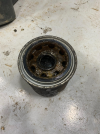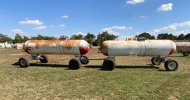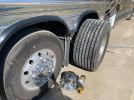- Joined
- Mar 2, 2005
- Messages
- 15,263
- Location
- Southeast Tennessee
- Display Name
Display name:
This page intentionally left blank
Kids would have their own cabin!
Finding a campsite would be interesting.View attachment 125245
I just found out I screwed up. I should’ve bought one of these.
The Prevost H5-60. 60 feet, articulated, 5 axles, and mod engine. What an Rv that could’ve been!
Just kidding. I’m very happy with my XL2-45.
Finding a campsite would be interesting.

I doubt it tows as well as yours.The Prevost H5-60. 60 feet, articulated, 5 axles, and mod engine. What an Rv that could’ve been!
False. Very easy to take off-road. Very difficult to get back on the road, though.You know, in the olden days, it wasn't unheard of for some people to get their own Pullman car.
Very difficult to take off road, though.
I doubt it tows as well as yours.
"Interesting" is the opposite of what I want in any towing scenario.That would be interesting.
"Interesting" is the opposite of what I want in any towing scenario.
That would be interesting. The way it's set up, the articulating rear is essentially a trailer ... So it would be kinda like a tandem trailer setup.
You left room to upgrade. Strategic thinking.View attachment 125245
I just found out I screwed up. I should’ve bought one of these.
The Prevost H5-60. 60 feet, articulated, 5 axles, and mod engine. What an Rv that could’ve been!
Just kidding. I’m very happy with my XL2-45.
Reversing a double trailer is fun.

12 air tanks. Did some of the Prevost engineers maybe start out working in Germany? Or Lincoln back in the 70s? I'm sure it all makes sense, it just seems like a lot.I posted another informative/maintenance video showing the locations and functions of all 12 air tanks on my bus.
12 air tanks. Did some of the Prevost engineers maybe start out working in Germany? Or Lincoln back in the 70s? I'm sure it all makes sense, it just seems like a lot.
Does the wet tank have a spitter valve?
Your bus is a delight to the types of folks who like to learn mechanical/electrical systems.
For me getting to know how all these systems work would be just as much fun as enjoying the bus itself.

To test it more you could've just driven around town today. It was a roller coaster going in and out of MKC today. Bleh.doesn't move quite as much under various gusting winds.
To test it more you could've just driven around town today. It was a roller coaster going in and out of MKC today. Bleh.
I'm not sure whether to be happy, sad, or laugh about this, but the upload of that driving audio is actually performing pretty well for my channel:
This blows my mind. Can you see how many people are just letting the whole thing play? This has to be a small cross section of people who spent years sleeping in the back of greyhound busses or team driving a semi.We drove the bus to Indianapolis for the eclipse, and stopped by Indiana Dunes National Park on the way. That put about another 1,000 miles on the thing, which made it the first trip we did with the new harmonic damper I added, plus a fresh oil change, first trip with the Flow Below wheel covers, and some more miles on the super singles (videos coming on several of these in the future).
None of these were things that I really expected to make a noticeable difference. That said, the engine does seem to be a bit smoother at idle than previously, and I also feel like the bus doesn't move quite as much under various gusting winds. This could just be perception, but the wheel covers should in theory reduce turbulence along the sides of the bus a little bit, so maybe there's something to it.
For the drive home from Indianapolis I did an audio recording of the full trip from the engine bay. This was actually a request from a YouTube viewer. It was an interesting challenge as I had to buy an audio recorder to add to the collection (which thus far seems to also be improving my audio for upcoming videos), figure out how to mount it in the engine bay, and then do some trial runs to figure out how I needed to set it to get good audio quality rather than massively distorted. It's pretty loud in there.
I'm not sure whether to be happy, sad, or laugh about this, but the upload of that driving audio is actually performing pretty well for my channel:
Now comes the prep for the summer travels. I need to do the valve adjustment on the engine (also setting the mechanical part of the mechanical/electric injector) and replace the air compressor and governor on the engine. From there I've got some other minor things to try to piddle through.
Is it the same people that watch people play video games? Are they using Ted's bus as a white noise machine and playing it on a loop?This blows my mind. Can you see how many people are just letting the whole thing play? This has to be a small cross section of people who spent years sleeping in the back of greyhound busses or team driving a semi.
Ugh. My kids do that. I'm about ready to turn off the internet.Is it the same people that watch people play video games?
Ted, I know you have many distractions, many things weighing heavily on your mind. Some focus might be in order. I believe that if you’ll take a walk in a quiet woods, find a peaceful spot to pause for a while, draw a deep breath and simply be still, you will begin to hear the still, small voice of an open-exhaust Wankle calling softly to you.
This blows my mind. Can you see how many people are just letting the whole thing play? This has to be a small cross section of people who spent years sleeping in the back of greyhound busses or team driving a semi.
Oh I’ve got a great engine swap idea there! More when I’m at a computer
